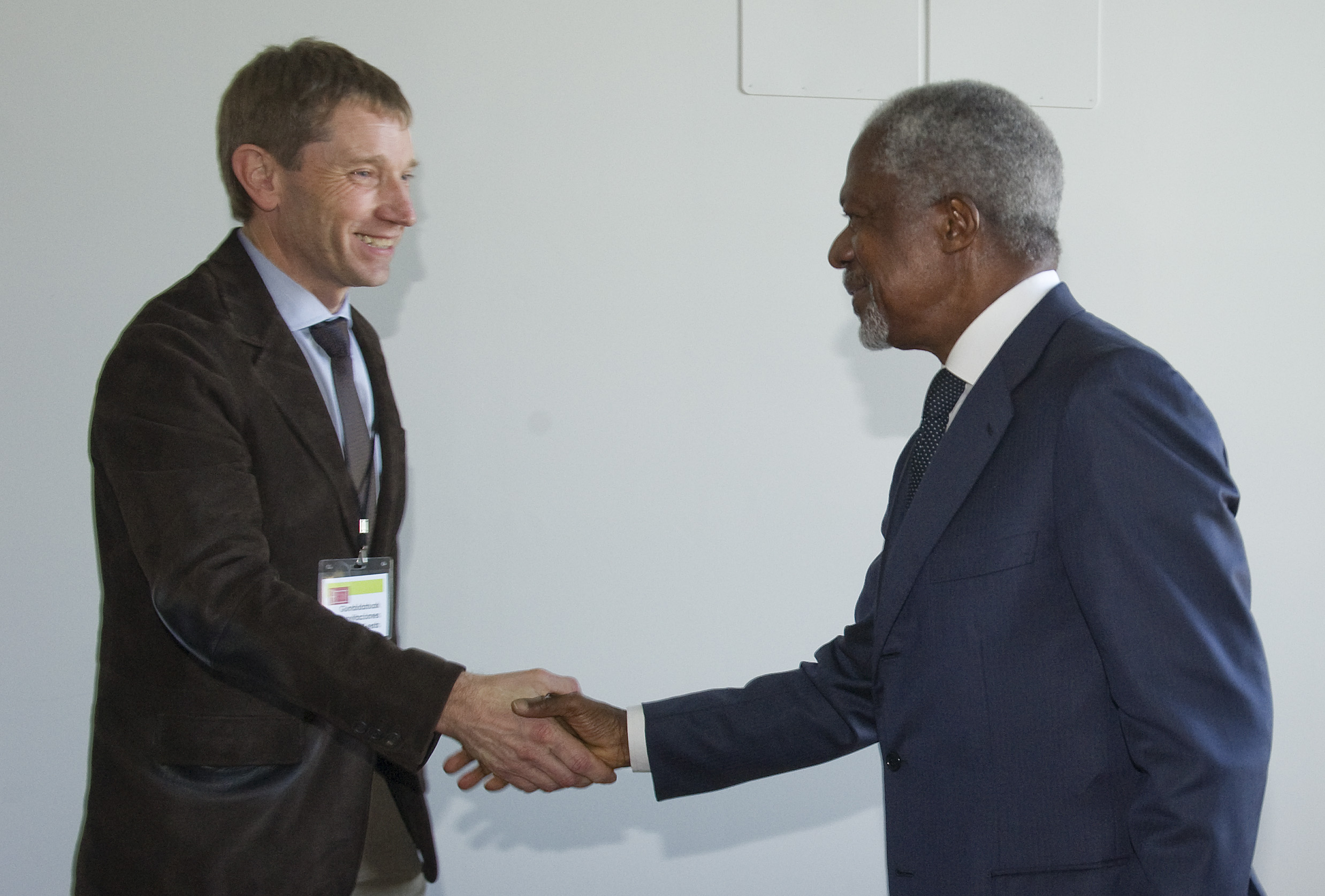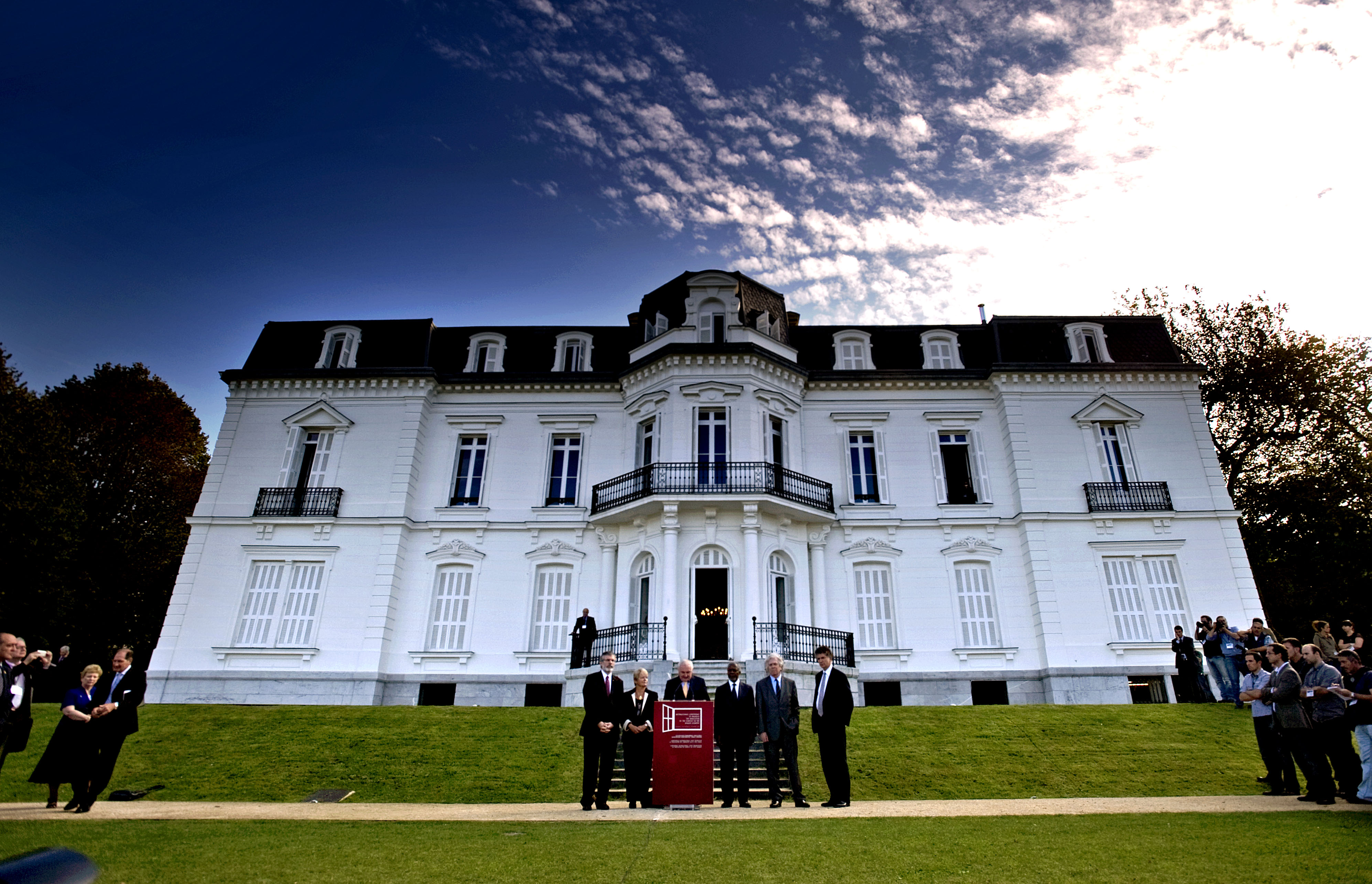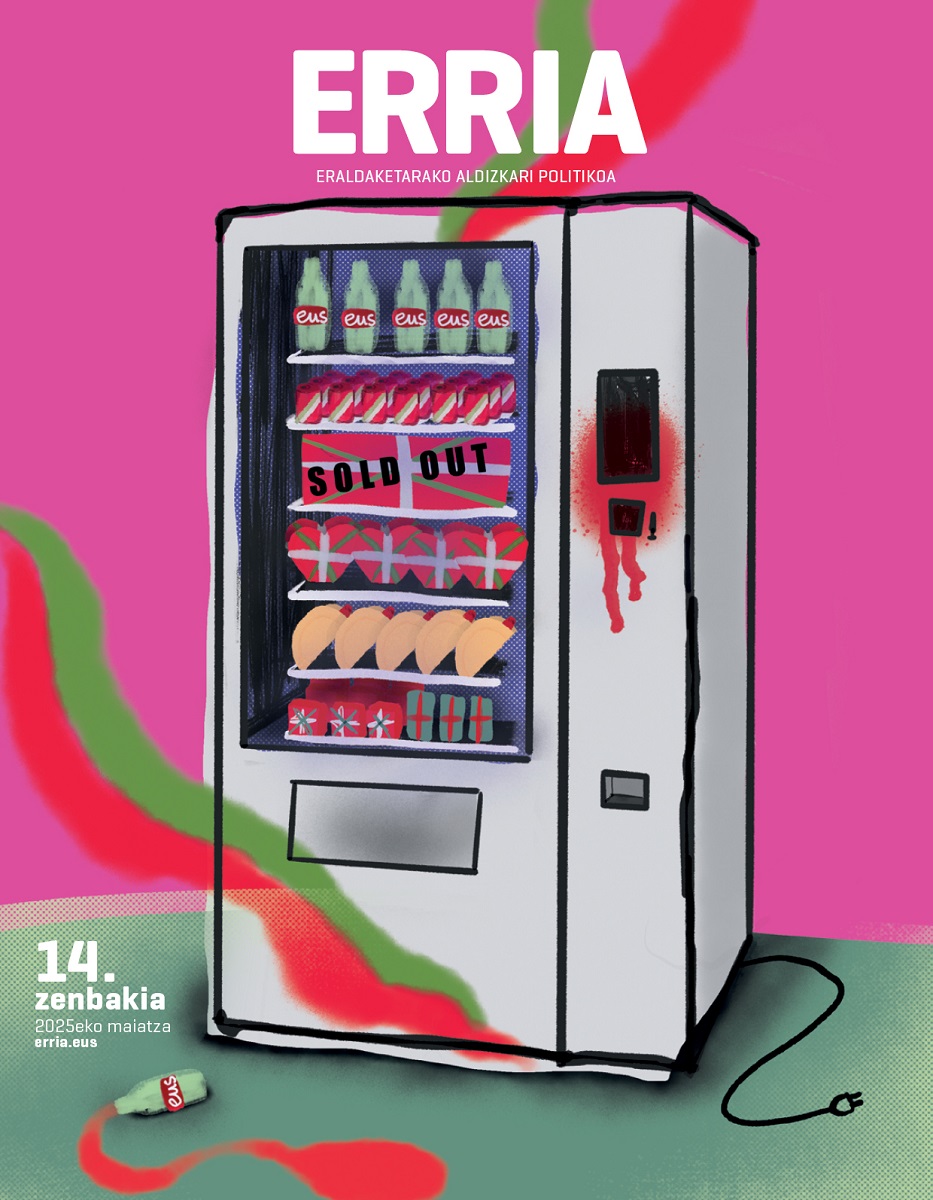SINADURAK

Urko Aiartza eta Rufi Etxeberria
Gatazkaren Ondorioen Konponbiderako batzordearen kideak
Ten years after Aiete Conference
2021-08-26EU
October 2021 will mark the tenth anniversary of the International Conference to Promote the Resolution of the Conflict in the Basque Country - more widely known as the Aiete Conference-.

Argazkia. FOKU / Rufi Etxeberria eta Koffi Annan.
The conference organized by the Basque citizens' group Lokarri and the International Contact Group to facilitate peace in the Basque Country involved leaders of Basque parties and civil society, as well as six relevant international personalities with notorious experience in the field of politics and pacification: Kofi Annan (former UN Secretary-General), Bertie Ahern (former Taoiseach of Ireland), Gro Harlem Brundtland (international leader in sustainable development and public health, former Prime Minister of Norway), Pierre Joxe (former Interior Minister of France), Gerry Adams (president of Sinn Féin, member of the Irish Parliament) and Jonathan Powell (British diplomat who served as the first Downing Street Chief of Staff). Tony Blair — former Prime Minister of the
United Kingdom — could not be present due to commitments in the Middle East, but he supported the final declaration. The former US President Jimmy Carter (2002 Nobel Peace Prize) and the former US senator George J. Mitchell (former United States' Special Envoy for Middle East Peace) also backed this declaration.
The conference resulted in a five-point declaration that included a plea for ETA to renounce any armed activities and suggested negotiations with ETA to the Spanish and French authorities to end the conflict.
As a result, on October 20 — ETA announced: "definitive cessation" of its armed activity.
Ten years later, we consider it is relevant to analyse how this event, which has remained a milestone in contemporary Basque history, was handcrafted.
The Aiete conference was the most public and significant event on a roadmap agreed upon during the summer of 2011 between ETA and the Spanish Government through a shuttle diplomacy exercise promoted by the HDC Centre.
As a result, both parties agreed to open a stage for negotiations on the consequences of the conflict. Those consequences referred to the prisoners' release, disarmament, and issues related to the past. However, this road map had nothing to do with the classic conditional negotiation processes. Instead, it was part of a different logic, and it requires an analysis of the reality of the previous Geneva negotiations between ETA and the Spanish Government of 2006 and 2007.
The breakdown of the 2006/07 negotiations left the Abertzale Left1 in a deep crisis. For the third time in history, after a negotiation process, the Abertzale Left got out weaker coming out of these talks than going in and, therefore, its weakness in general terms was increasing. While in the Abertzale Left ("Ezker Abertzalea" in the Basque language) is the usual name to refer to the Basque National Liberation Movement. Abertzale would mean "patriotic" rather than nationalist.
2006/07 negotiation process, the Spanish State strengthened its BATNA (which defines the best alternative to reaching a negotiated agreement), the Abertzale Left did not work on it properly, and the breakdown of the process weakened it, plunging the Abertzle Left into a deep crisis. Basque society largely blamed the patriotic left for the breakdown of the peace process, the international community did not understand why the process had broken down when it had reached that level, and the different militant groups and structures of the movement got disoriented.
The Spanish State used the negotiation process, as always did, to improve and deepen its intelligence in the fight against ETA and to develop a comprehensive strategy of exclusion and political substitution of the Abertzale Left. The Spanish State had developed a whole strategy (political/police/judicial/international) to destroy the Abertzale Left. The Spanish intelligence services were already dreaming of military and political victory. One politician of the time publicly put it this way: "They may have ended up like the IRA, but they will end up like the GRAPO".
There was a need for strategic clarification. Previous negotiation models could no longer be adopted. The prospect of a possible new bilateral negotiation that could advance by developing military force was very remote. Meanwhile, the Abertzale Left was squandering the historical political accumulation achieved over the years with the risk of coming to politically nothing.
So, what was the point of trying the same formula for the fourth time?
ETA could not be militarily defeated, as the figures of its internal process for dissolution showed: 3.000 people were involved in the process, with 1335 members with the right to vote. However, at the same time, it was clear they
could not achieve their goals. There was evident exhaustion. It was necessary to pull out of the abyss. Faced with the State's operational and strategic advantage, the Abertzale Left needed to leave the current battlefield, seeking a new battleground that was more suitable and more far-reaching for
the movement to accumulate forces and confront the State in better conditions.
Furthermore, in this new scheme, the armed struggle ceased to be effective, while the programmed deactivation of the armed struggle could play an active role in creating the new accumulation of forces needed to advance. This reflection was perhaps internalised too late, as the ideal moment to do so was 2006/07, or earlier. However, at that time, the patriotic left still saw the negotiation as just another front instead of considering it as a new phase. The conception of the negotiation as a front meant that armed actors could open and close it, mutually feeding off other fronts; the definition of the negotiation as a new phase meant, on the other hand, the internalisation of a new and complete logic in which there was no turning back; the negotiation phase was a new phase of the liberation process with its own rules.
The Spanish State, of course, was not going to contribute to this change of strategy because the State's objective was the political destruction of the Abertzale Left. Therefore, the patriotic left had to find new travelling companions, creating new conditions that would allow it to expand its forces further to move closer to its political objectives. Moreover, it was clear that the State would try to neutralise this. That was the reason for the police operation that later became known as "Bateragune", where Spanish forces arrested the core group in charge of the strategic transformation, including Arnaldo Otegi. The State aimed to leave the Abertzale Left as weak as possible during this process, promoting divisions and contradictions.
The strategy of the patriotic left was based, on the contrary, on two main directions: one towards the international community, to achieve the complicity of some external agents in favour of the process opened in Euskal Herria and, on the other hand, towards the Basque sectors that might be in favour
of an unarmed liberation process. The new strategy demanded new accumulations of forces, and this necessarily had to set the Abertzale Left on the path towards a non-armed strategy.
All these also required the construction of new dimensions concerning the process. In the patriotic left's and its DNA, the deactivation of the armed struggle was rooted in the bilateral logic. The Abertzale left always linked the end of armed struggle to contents developed and agreed with the State in a negotiation table. The new logic situated the cessation as a sovereign decision, with the new possibilities this could bring as its primary purpose. Abertzale Left defined as unilateralism (as opposed to bilateralism) taking the political initiative and taking advantage of the opportunities generated by the unilateral cessation of the armed struggle on the road to creating new opportunities, new "momentum".
This concept has been often narrowly understood. Unilateralism did not mean that the Abertzale Left believed that it could do everything on its own. Instead, it was about acting in the same way as when playing billiards; when hitting a ball, the aim is to reposition the balls, creating new scenarios and possibilities. The change of situation could push other agents to take new steps.
Before Aiete, this strategy had several achievements. On the one hand, activation of the international support with the Brussels Declaration, the International Contact Group, and the International Verification Commission. On the other hand, the Gernika Agreement among Basque political forces, unions and civil organisations. Finally, the Abertzale Left, Eusko Alkartasuna and Alternatiba, with their consensus and the legalisation of Bildu, helped to overcome the period of banning. Moreover, its presence in the 2011 municipal elections demonstrated the potential of the new political strategy by winning important mayoralties such as that of San Sebastian and the Provincial Government of Gipuzkoa.
As mentioned above, all these initiatives involved a recomposition of indirect relations between the Spanish State and ETA. After the end of the 2006/07 process, maintaining communication channels was one of the challenges for the Abertzale Left, keeping the involvement and international support
achieved until then in favour of a solution through dialogue.
By then, the Spanish Government had already ruled out the possibility of a split in the patriotic left and, instead, saw the end of ETA's armed activity as a political opportunity. Thus, José Luis Rodríguez Zapatero, then prime minister of Spain, could capitalise on the outcome before the elections. In this scheme, the possibility of a consensual road map emerged. Unfortunately, as Eisenhower said, "a plan is nothing but planning is everything"; in other words, a plan usually comes to nothing when it collides with reality.
However, the planning and strategy carried out until then would be of solid value. Why do we say that? In the summer of 2011, President Rodriguez Zapatero tried to deny the ongoing profound economic crisis but reality forced him to bring forward the 2012 elections. It was clear that he would probably lose
the elections, so he stepped aside and proclaimed Alfredo Rubalcaba as a candidate, hoping that the bleeding of votes would stop. He thought voters would reward Rubalcaba for his performance as Interior Minister.
The Abertzale Left had two options in this new scenario. One was to wait for the new Government to be formed and negotiate with them the road map. After all, the new Government resulting from the elections was the one that would have to implement the road map; even more so when the early elections made it challenging to develop the foreseen scheme, that is, the PSOE government would not be able to take a series of measures and engage in at least initial talks with ETA. The other option, even with all the risks, was to move forward. Within this logic, it was preferable to leave the process rolling without waiting for what the new Government would do, and thus make it more difficult for the next Government to destroy what the previous Government had set in motion.
Therefore, Abertzale Left gave priority to the second option, and in the summer of ten years ago, the international mediators set about designing the so-called "Resulting Roadmap". The main milestones in this road map were holding the Aiete Conference and the location of the ETA delegation in Oslo. "Facts on the ground". Aware of the Spanish Socialists' habit of not keeping their word, it was necessary to lay the foundations for future talks, and for that, ETA requested the transfer of their delegation to Olso before the Conference.
As we said, the agreed road map departed from the negotiation schemes designed on previous occasions. The Abertzale Left had already taken some strategic decisions, especially those relating to the end of the armed struggle. Therefore, the road map was not a bilateral agreement in which the issue of the armed struggle was a determining factor, and, of course, it was clear that once the cycle of the armed struggle was closed, the armed struggle would have no capacity of influence.
Nevertheless, on the other hand, this decision was an advantage, given that if there were not a consensual process, the State would not influence the decision of the patriotic left by failing to fulfil its commitments as in previous processes. Thus, the logic was different: the idea was to create new
leverages with each event and improve the conditions to take new steps.

Argazkia. FOKU / Nazioarteko ordezkariak Aieteko Konferentzia amaitzeko, bost puntuko agiria irakurtzen. Euskal Herriko gatazka politikoaren ondorioak eta muina konpontzeko bideorria proposatu zuten.
The Aiete Conference had the objective of creating a new scenario with its new opportunities and threats. Among the threats was the attitude that Mariano Rajoy's Conservative Government could adopt. Rajoy could decide to do nothing in the new scenario to let the process fester. Faced with the new PP Government to form after the elections, the Abertzale Left contemplated that this Government would have three options: to resort entirely to the destruction of the process, maintain the path of low-intensity repression and thus let the process fester, and to tackle the process. Thus, it tried to drive the process into the abyss by combining persecutions and letting it fester.
It is true that, once the end of the armed struggle happened, nobody (neither in the Basque Country nor internationally) had foreseen that the Spanish Government would oppose the disarmament process and activate a strategy of obstruction. However, in Rajoy's Government and the PP's strategy, the idea that despite a possible victory in the military field, the sense that some voices defined as "the victor's defeat" became strong. According to them, the Government was losing the political battle against the patriotic left. After Aiete, and in a few years, this deadlock scenario prompted the Abertzale Left to adjust the strategy it had adopted but not to change it.
Once again, "a plan is nothing, planning is everything".
On the other hand, in the context of the Aiete Conference and ETA's Declaration of 20 October 2011, there was also a new electoral map marked by the powerful electoral results of Amaiur and EH Bildu, and consequently, a new balance of power. The new situation led, among other things, the Basque Nationalist Party (EAJ-PNV) and Mr Urkullu's Regional Government to adopt a reduced and partisan vision of the process that opened up in Aiete. This position made it very tortuous for the process to move forward in the following years because irresponsible partisan behaviour played too significant a role in resolving the conflict. However, it is worth highlighting the scenario opened up by the policy of collaboration adopted by the majority of the agents in the
North Basque Country (French Basque Country) after Aiete, both institutionally with the creation of the Basque Country Intermunicipal Community and in the resolution of the consequences of the conflict, especially with the disarmament process. Thus, the North Basque Country has been vital in the evolution of the process as a whole after Aiete.
In short, the Aiete Conference was a significant milestone in the new strategy designed by the Abertzale Left after 2006/07, as the leading indicator of the new logic, thereby laying the foundations for what has followed in subsequent years, up to the present day. However, nothing works linearly, and the Abertzale Left will have to continue to make adjustments in developing its strategy and creating new scenarios to pursue its legitimate goal for Self-determination.


